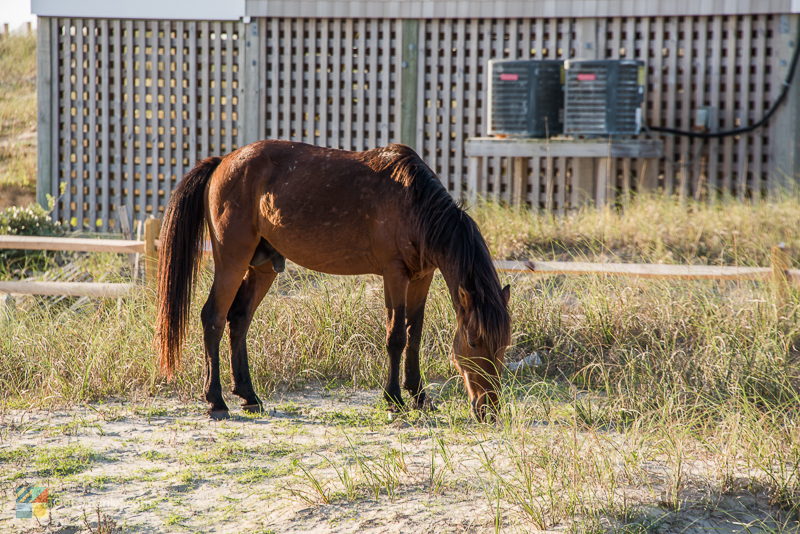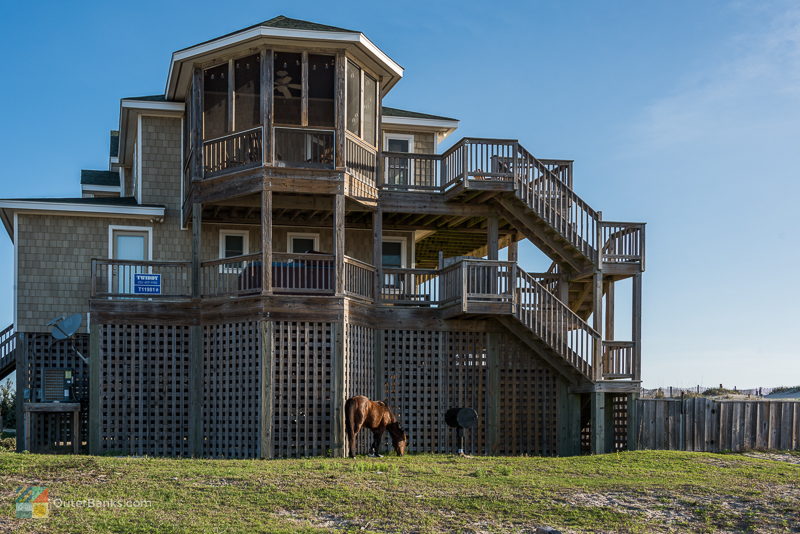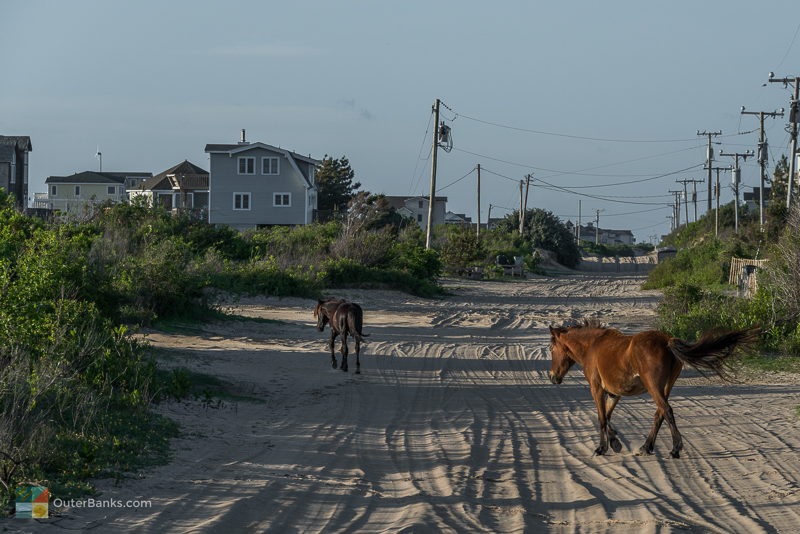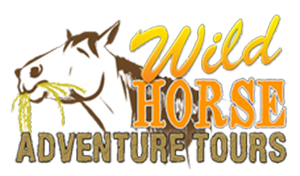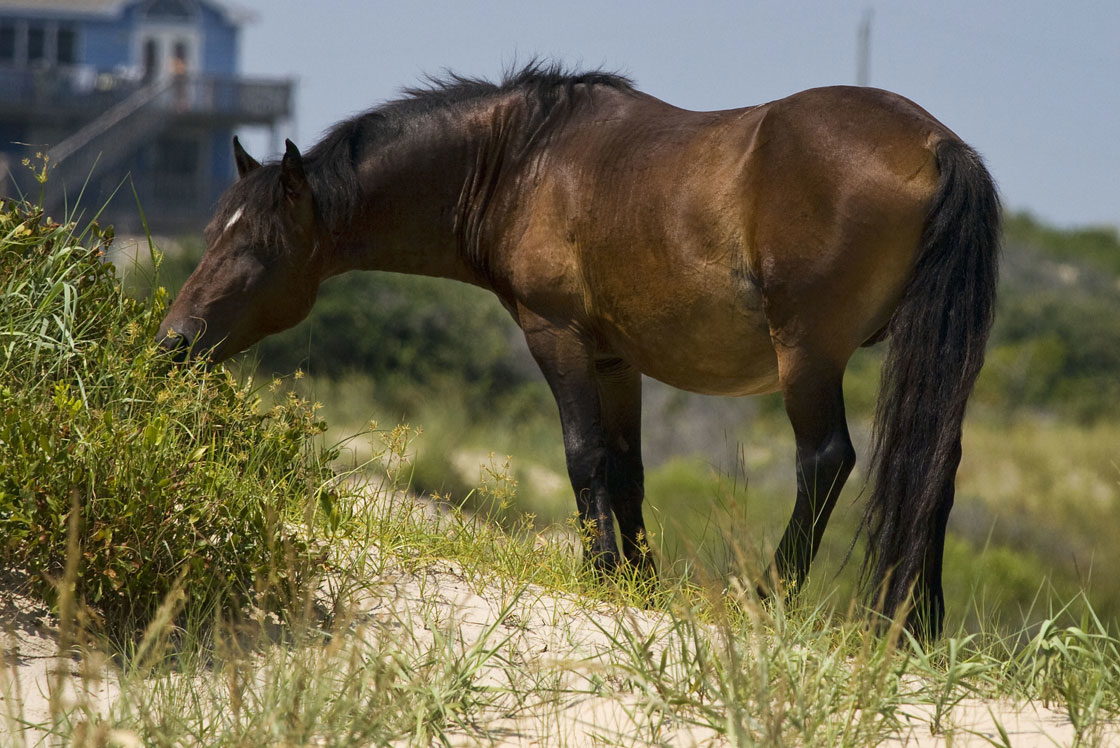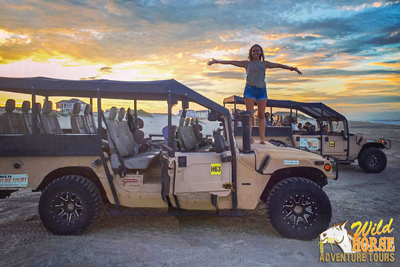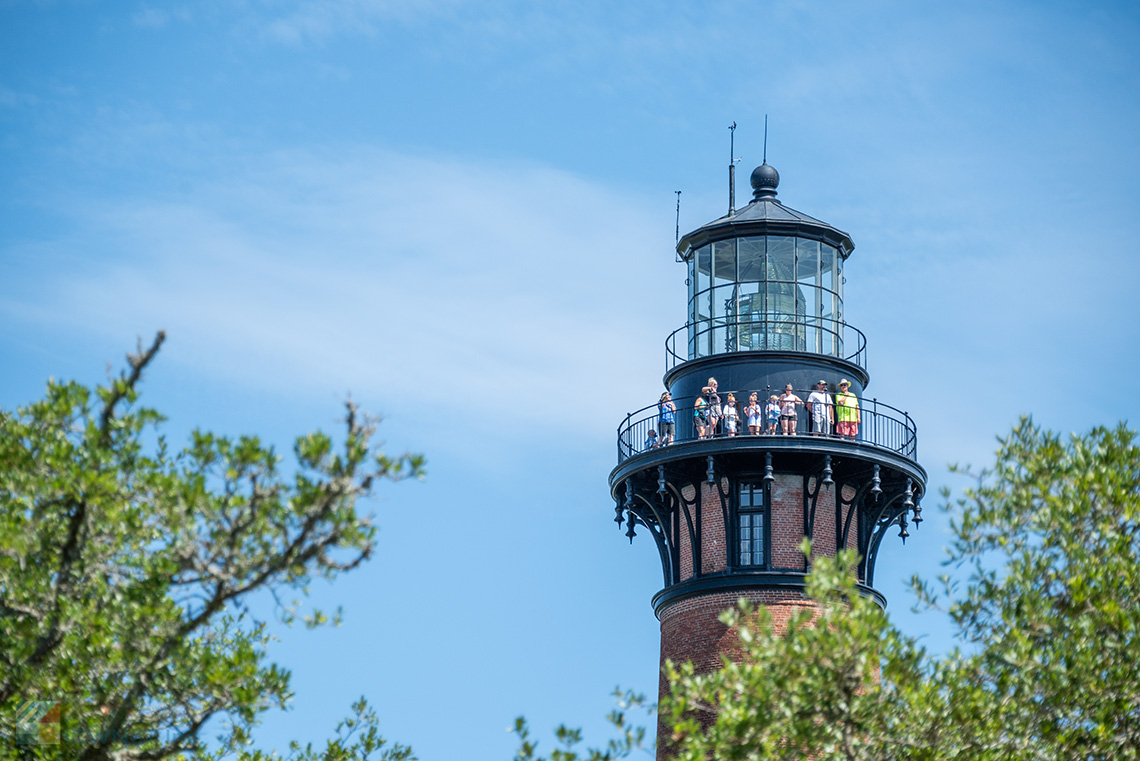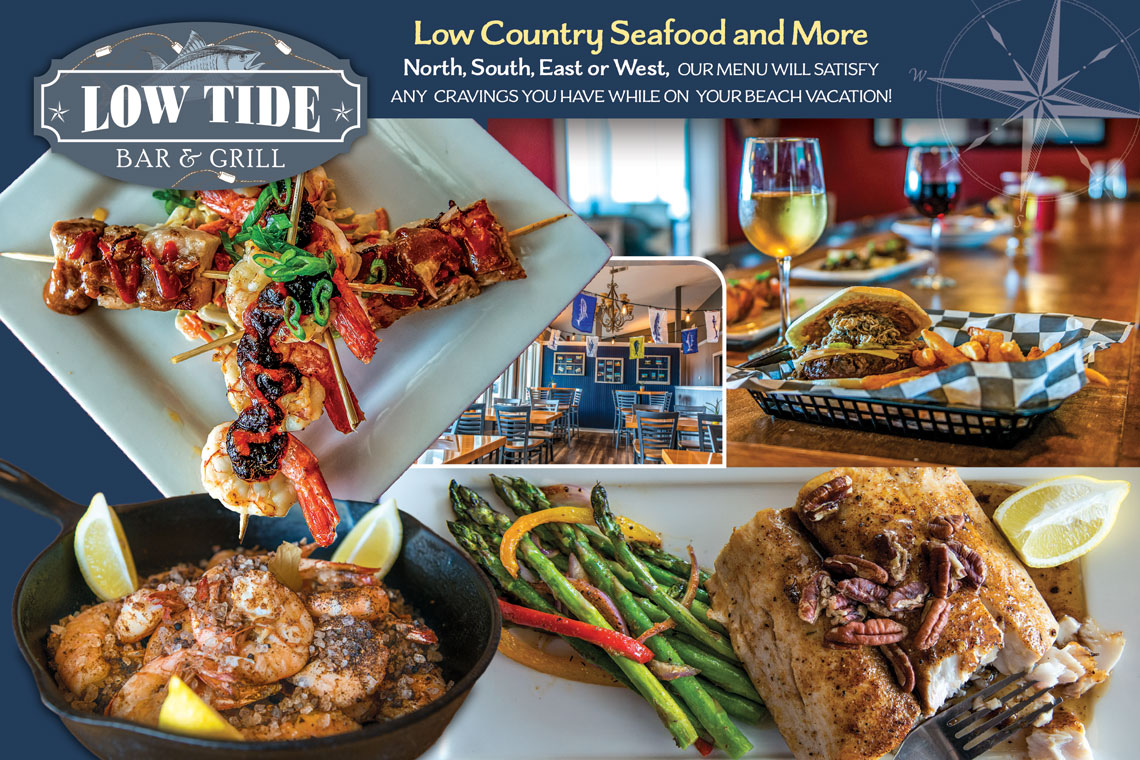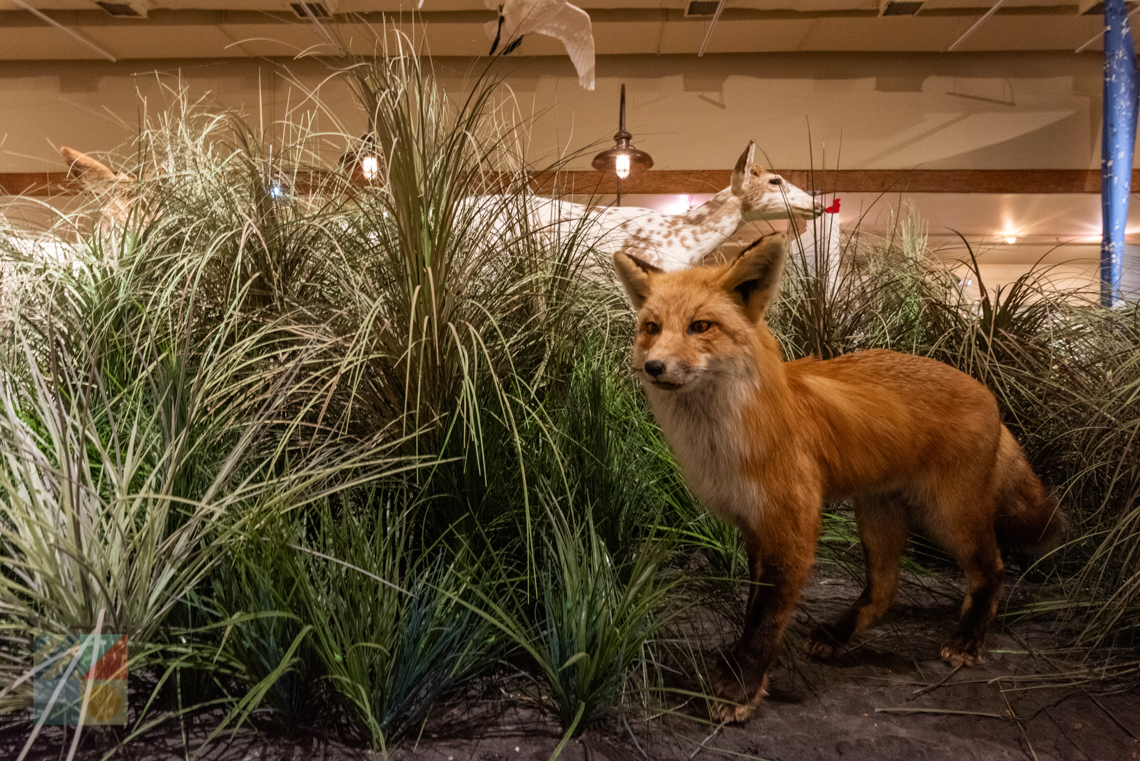OuterBanks.com would like to thank Wild Horse Adventure Tours for supporting this content. Wild Horse Adventure Tours are seasoned vets when it comes to searching for the wild horses in their 4x4 off road tours. Their open-air cruises traverse beaches, dunes and Maritime forests with exclusive access to a wild horse sanctuary. Wild Horse Adventure Tours was ranked as the #1 tour in the USA by Tripadvisor and 2018 Business of the Year by the OBX Chamber of Commerce. Check out the wild horses in their tour video here, or call 252-489-2020 for more information.
Corolla Wild Horses Guide:
- Local Guided Tours
- Where to See the Horses
- Wild Horse Fund and Museum
- Wild Horse History
- Frequently Asked Questions
Visitors to the 4WD accessible beaches just north of Corolla may experience a truly remarkable encounter with the area's oldest and most beloved residents, the Wild Colonial Spanish Mustangs. Stranded on the Outer Banks for centuries, but still enjoying the laid-back beach lifestyle, these feral and wild creatures are tolerant of the visitors who visit their beaches for the warm sun, cool waves, and miles of space.
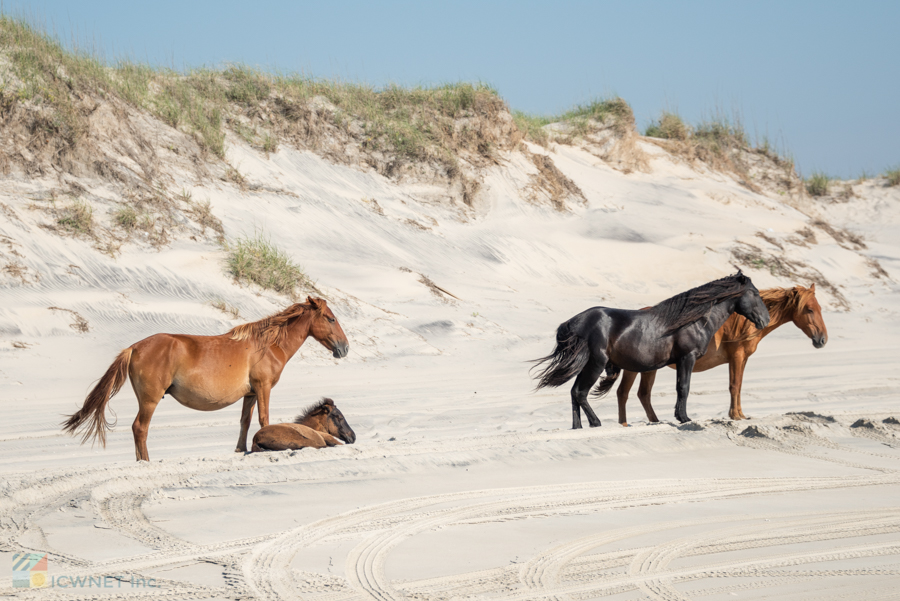
It's because of this desolation, coupled with the help from the Corolla Wild Horse Fund, that the wild horses are able to thrive, relatively undisturbed by the limited development that has sprung up around them over the past 50 years. Obviously, vacationers won't be able to expect to ride the horses, or come close enough for a pet on the neck. Visitors are reminded that the Wild Colonial Spanish Mustangs are, in fact, wild. It is illegal (and dangerous) to approach within 50 feet of the horses. It is also illegal to feed them. Wild horses have a very different diet from domesticated animals. Fruits and vegetables can cause serious injury or even death to the horse. That said, admiring the horses from a distance is its own reward, and the photos that can be snapped of a small herd wandering along the ocean wash, or grazing lightly in the sand dunes, are easily the most treasured souvenirs of any Outer Banks vacation for lucky Carova visitors who just happen to cross their path.
On your next vacation, consider a day trip to the northern beaches of Carova to catch a glimpse of the wild horses, and remember to always keep your eyes peeled - the Corolla Wild Horses may very well be enjoying a nice beach day just around the corner.
Corolla Wild Horse Tours
For those who want a better chance at spotting the horses in their natural habitat, consider a Corolla Wild Horse tour. These tours are administered seasonally by both the Corolla Wild Horse Fund and privately run businesses like Wild Horse Adventure Tours that specialize in bringing visitors to the wild horses' favorite stomping grounds, increasing a vacationer's chances of spotting one of these somewhat elusive local legends.
Most horse tours are conducted in a customized 4x4 off-road vehicle. Participants ride in comfort with enough seating so that all tour goers can simply climb aboard, sit back, take photos and learn from a friendly and experienced guide.
Corolla Wild Horse Tours generally last two hours, and explore the northern Outer Banks beaches from the outskirts of Corolla all the way to the Virginia State Line. Along the way, the tour may stray from the oceanfront and onto wooded neighborhood or public sandy paths where the horses are known to flourish.
Offered seasonally, tour goers are encouraged to bring plenty of sunscreen, extra water for the excursion, and of course, a camera. Once the tour encounters a small pack or an individual wild horse, photos are all but required, and are sure to be a treasured acquisition from your Outer Banks vacation.
Highly-rated tour companies like Wild Horse Adventure Tours recommended reservations, especially in the summer season months of June, July and August when Corolla's tourism and population is at its highest. Last minute tours are occasionally available for small parties, however, or for folks travelling to the Outer Banks in the shoulder season months. Be sure and check online or call your favorite tour company in advance of your vacation to find specific prices and available dates.
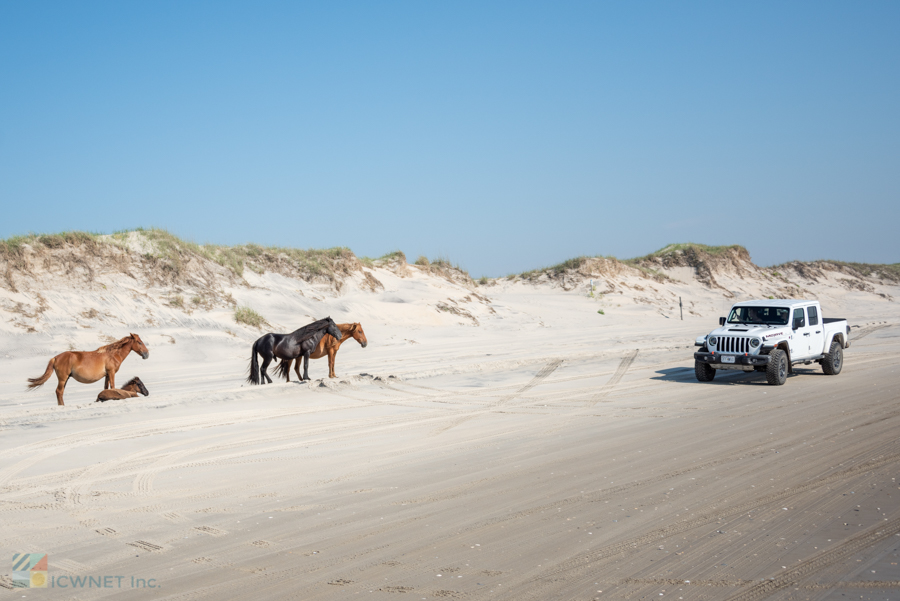
The Corolla Wild Horses have been a draw to vacationers for decades, as their mystique and centuries old legacy is simply unmatched on the OBX coastline. It's no wonder that popular fiction and movies, such as "Nights In Rodanthe" has romanticized their presence, and why so many vacationers fall in love with the wild horses and make a visit to the Corolla Wild Horse Fund every year to find out how they can help.
If exploring the wild roots of the Outer Banks is on your vacation agenda, then schedule a wild horse tour or simply take a long drive on the beaches of Carova, and see if you can observe these original natives on your own. The Outer Banks has always been revered as a little bit wild but steeped in history, and a glimpse of the wild horses will certainly bring this reputation come to life.
Where to Spot Corolla Wild Horses
The Corolla Wild horses tend to congregate in small herds, and can be seen just about anywhere along the northern 4WD Outer Banks areas, from the backyards of wooded rental cottages to the oceanfront beaches, surrounded at a distance by happy beach-going families.
The horses are somewhat smaller than modern varieties, with an average height for adults of about 7' ft. tall. Generally a uniform color of brown, (and in all shades from honey to almost-black chocolate), with a thick sandy mane, the horses are certainly distinctive, and equally honor their Spanish predecessors.
Many Outer Banks visitors who rent a vacation home in Carova see the horses in their backyards or walking down the shady roadways, which are practically hidden by clusters of live oaks and decades-old cedar trees. Others may simply be driving along the beach and notice a small group exploring the water. It's impossible to predict where and when a wild horse will appear, but a long stay on the beach or a calm journey down the coastline are ideal locations to start looking.
The one thing any wild horse enthusiast should always bear in mind is to keep your distance. These horses look completely docile, and in most cases they are, but in actuality they have been feral for hundreds of years and do not interact with the local human population. Never touch, approach, or feed the local horses - like anything wild, they are best admired from a distance, and hopefully with a camera with a very good zoom lens. Feeding or encroaching within 50 feet of a wild horse is illegal and dangerous to both humans and the horses.
Visitors to Carova are also cautioned to drive slowly along the beaches, and maintain the local speed limits along the shoreline. More horses are injured or even killed by vehicles than by any other unnatural factors, so maintaining a slow speed, which allows a driver plenty of time to break or swerve in case of their imminent arrival, is a key factor to their preservation.
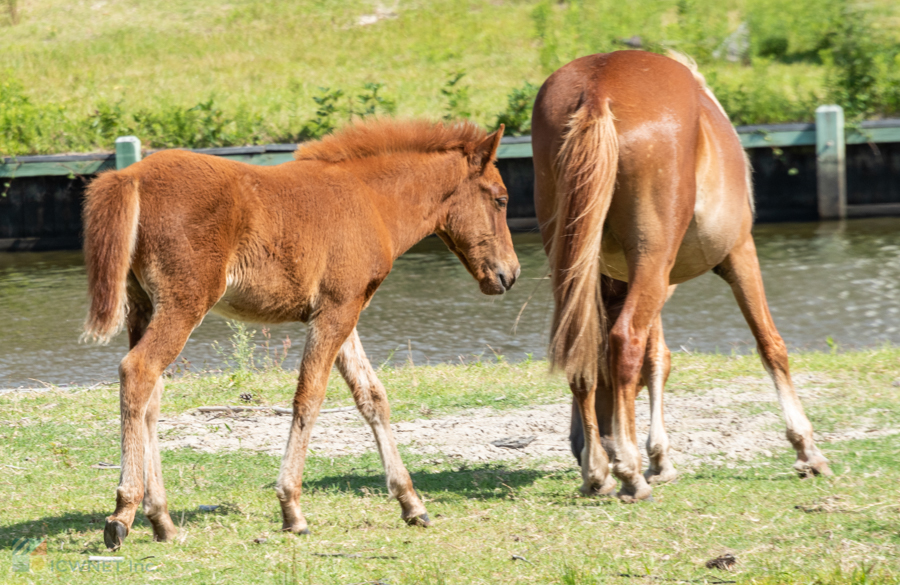
Above all else, in order to spot the Corolla Wild Horses, simply be quietly observant. They can appear when you least expect it, either crossing your path on your first expedition to Carova, or years after you've vacationed on the islands. Patience and simple enjoyment of the gorgeous northern Outer Banks beaches goes a long way in securing a sudden and unexpected wild horse spotting.
If you're having trouble locating the wild horses, try booking a tour with an experienced guide.
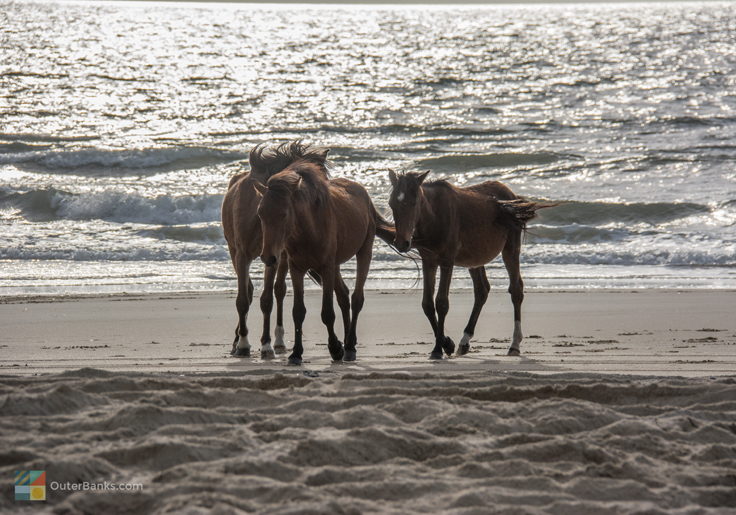
The Corolla Wild Horse Fund and Museum
By the mid-1980s, the northern areas of the Outer Banks had become more developed, and with the influx of people and vehicles, the wild horses, who were used to having miles of Corolla shoreline all to themselves, became increasingly in danger or being threatened by the incoming population. In fact, the Corolla Wild Horse Fund estimates that between 1985 and 1996, when development was soaring, 20 horses were killed or injured by passing vehicles along NC Highway 12, the only highway that runs through these beaches.
As a result of efforts by both the Corolla Wild Horse Fund and regional and national government, by 1997, all of the horse were relocated to the northern beaches of Carova, which were (and still are) unpopulated and only accessible by a 4WD vehicle. Two sound to sea fences were constructed 11 miles apart to keep the horses from wandering into more congested areas - one is located along the northern Corolla border, and one close to the Virginia state line. As a result, this new wild horse habitat offers the horses over 7,500 acres of coastal shoreline, maritime forests, and all the dunes, marshes and small estuaries in between.
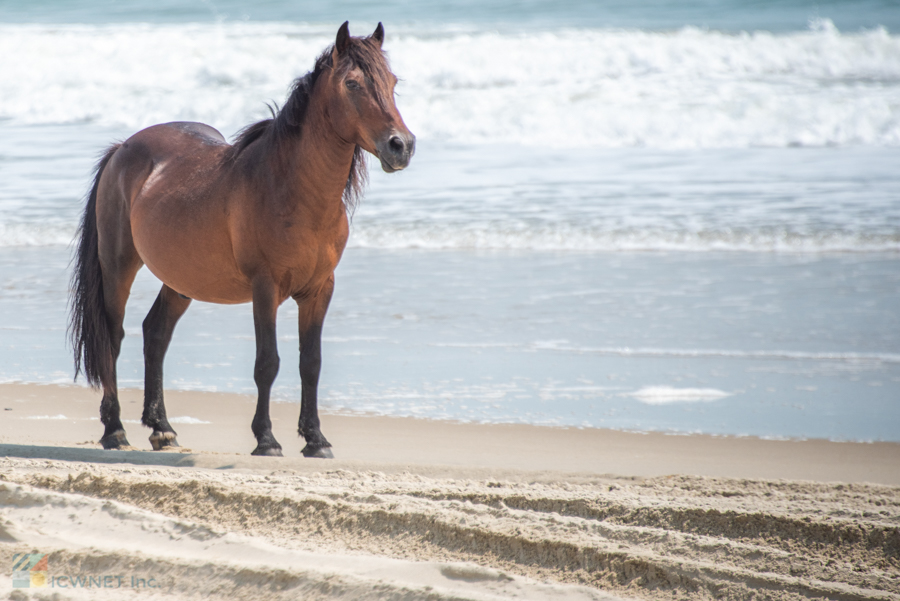
The Corolla Wild Horse Fund estimated that approximately 1/3 of the horse "sanctuary" is public land, and 2/3 is private land, comprised of local vacation homes or undeveloped lots, but homeowners and vacationers alike certainly don't mind sharing their backyards with the passing wild natives.
Since its incorporation as a nonprofit charity in 2001, the Corolla Wild Horse Fund has prided itself on its mission "to protect, conserve, and responsibly manage the herd of wild Colonial Spanish Mustangs roaming freely on the northernmost Currituck Outer Banks, and to promote the continued preservation of this land as a permanent sanctuary for horses designated as the State Horse and defined as a cultural treasure by the state of North Carolina."
In order to accomplish their goal, the Corolla Wild Horse Fund employs four full-time staff members who are active both in the field and at their home office, located within the original Corolla schoolhouse, as well as a number of seasonal staff and local volunteers.
The staff respond to emergencies regarding the horses, conducts DNA testing and local soil and plant studies, maintains the area fencing, and provides the public with a world of local information or activities to both introduce them to the local wild horses, and get them involved in their preservation. For example, the Corolla Wild Horse Fund provides seasonal children's programs, and even "adoption" opportunities for horse lovers to adopt and sponsor a local Corolla Wild Horse.
All wild horse sponsors receive a professional and embossed presentation folder, which includes a color photo of their adopted horse, a history of his / her life on the Outer Banks, and an official adoption certificate. Best of all, after becoming a sponsor, the Corolla Wild Horse Fund will provide regular updates on the horse's activities and locations 4 times a year, allowing the sponsor to always stay involved on or off the island.
The Corolla Wild Horse Fund's home base of operations at the original Corolla Historic Schoolhouse also features an interactive wild horse educational museum and museum store, which is open year round. An additional seasonal museum store is also located at the Corolla Light Towne Center, and horse lovers will be happy to know that all proceeds from either shop are directly given to the Corolla Wild Horse Fund for care and maintenance of these Outer Banks natives.
The group has become a fixture on the northern Outer Banks, both for their long history of determined action and compassion, and their visible yet historic location at the Corolla Schoolhouse. For more information about the horses, or to find out how to get involved in their preservation, a stop by the Corolla Wild Horse Fund's office and museum is definitely a must for Outer Banks animal lovers.
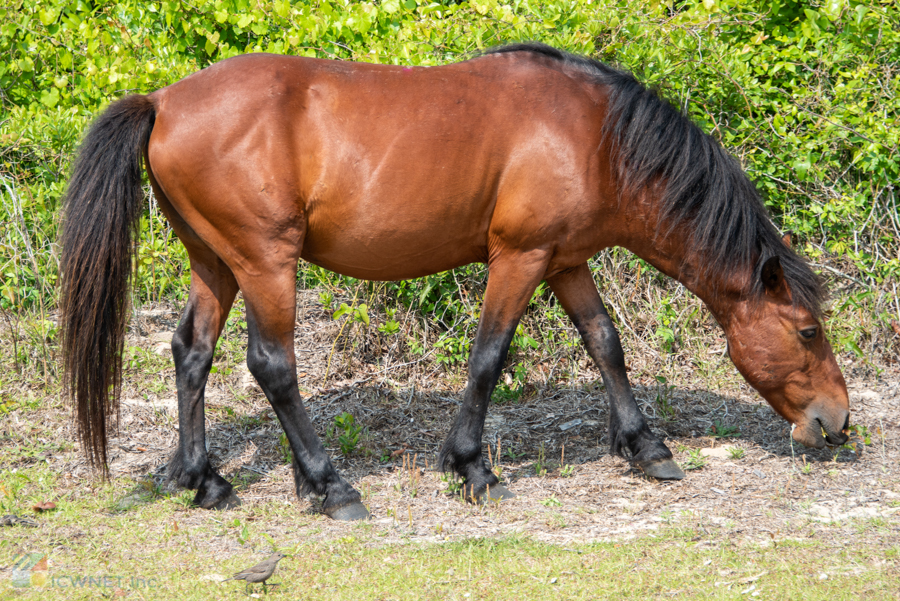
The History of the Corolla Wild Horses
The origins of the Wild Colonial Spanish Mustangs date back nearly 500 years, making them the earliest settlers of the Outer Banks, and some of the earliest residents, second only to the local Native American tribes. While historical journals, documents and ship's logs hint to the wild horses' origin, it's hard to determine one specific set of events that led to their presence on the Outer Banks.
It's possible that the horses were left behind by one of the first explorers to the North Carolina Coastline, a Spanish explorer named Lucas Vasquez de Allyon. In 1521, Vasquez de Allyon commissioned his commanders to explore and colonize the entire American eastern seaboard, and at least a handful of these commanders landed somewhere along the North Carolina shoreline. While many modern historians believe the majority of these initial explorations happened somewhere around Cape Fear, (due to multiple references to the large saltwater river), it's possible that these expeditions led them all the way to the Northern Outer Banks.
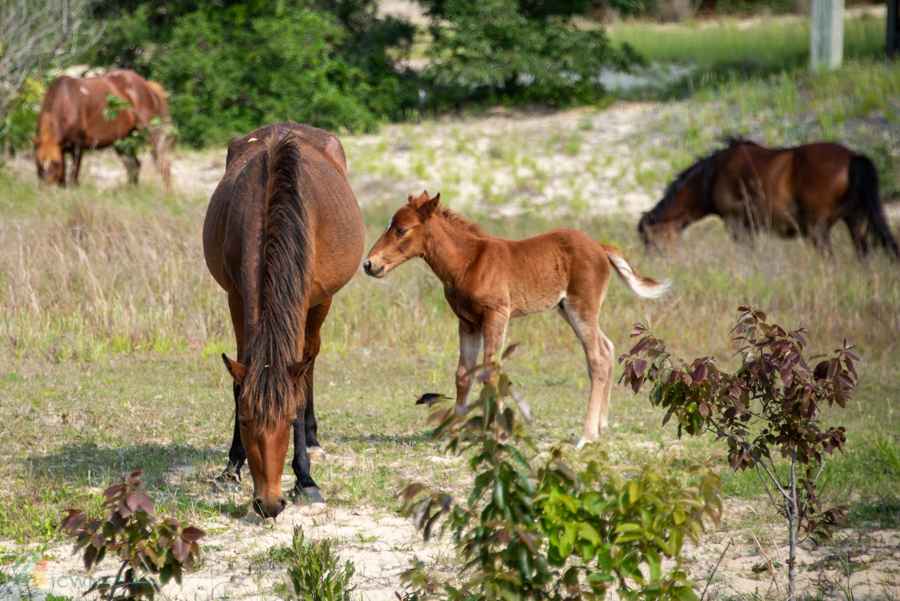
Unfortunately for these first explorers, local Native Americans did not appreciate the intrusion, and a number of attacks and minor wars broke out along the North Carolina coast, prompting the Spanish to abandon their early ramshackle settlements and leave their livestock behind. Though remote, there is a slight possibility that this is the origin of some of the NC banker ponies, which are scattered from the Cape Lookout National Seashore to Ocracoke Island and all the way to Carova.
A more feasible origin story dates back to just 60 years later, during one of Richard Greenville's expeditions along the North Carolina coastline. Greenville was an English commander overseen by Sir Walter Raleigh who made regular routes along the coastline from the West Indies, to the early colonies of North Carolina and Virginia, and back to England. The late 1500s were a time of English expansion and colonization, as well as trading and commerce in the southern West Indies, (even among the Spanish who still frequented the coastline but were technically at war with England), and as a result a number of European ships would pass by the Outer Banks waters.
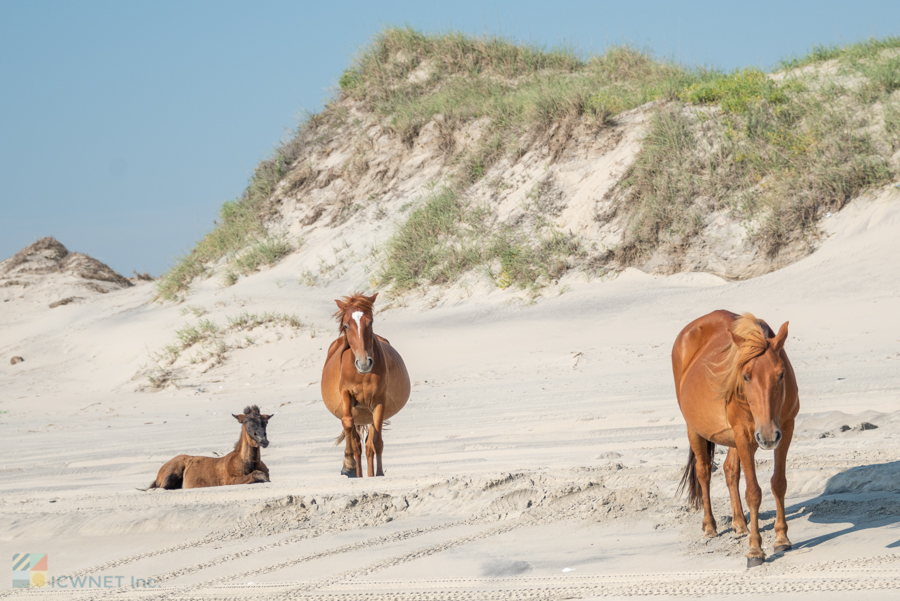
In June of 1587, Greenville was leaving the West Indies with a healthy cargo of sugar, food, and livestock, (including Spanish mustangs), and was heading up the coast along with a small fleet of ships to carry the supplies, in order to deliver the goods to the newly established English colonies. Historical records indicate that Greenville and his small fleet had trouble along Cape Fear, and then on the outskirts of Portsmouth Island, with the ships catching in the dangerously shallow Diamond Shoals. One ship in particular, the Tyger, was lost to the battering waves and the livestock floated ashore or were lost at sea.
While these cases are two of the most documented theories for the wild horses' presence, they certainly aren't the only explanations. A number of local experts believe that the horses, which are clearly descendants of Spanish Mustangs, were washed ashore by Spanish or English shipwrecks in the 1500s. This theory is based on the appearance of the horses themselves, as well as early 1700s to 1800s accounts of Corolla visitors or settlers who spotted them and made note of the horses in their journals.
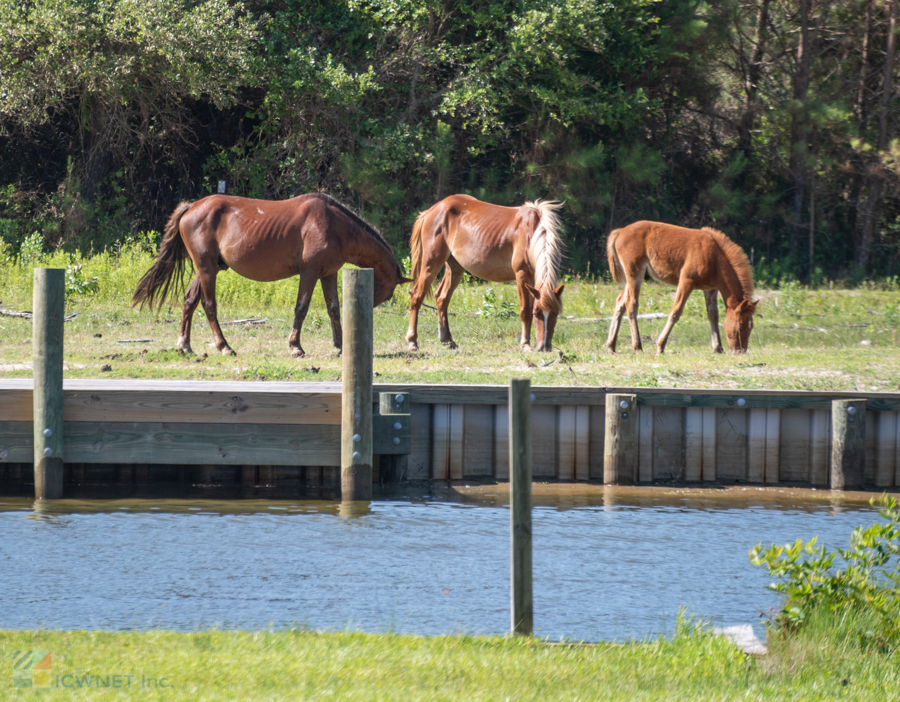
For example, English explorer John Lawson who explored the North Carolina Coastline in the 1710s, mentioned them in his reports, noting that "The horses are well-shaped and swift. The best of them would sell for ten or twelve pounds in England. They prove excellent drudges, and will travel incredible journeys."
Regardless of their actual roots, one of the allures of the wild horses is, and has been for centuries, their mysterious appearance on the Outer Banks. Whether they are intrepid survivors who indeed "traveled incredible journeys" from ancient shipwrecks off the coastline, or the descendants of livestock that were left behind by the earliest of colonists, the unclear ancestry of the Corolla Wild Horses is clearly part of the allure of their story.
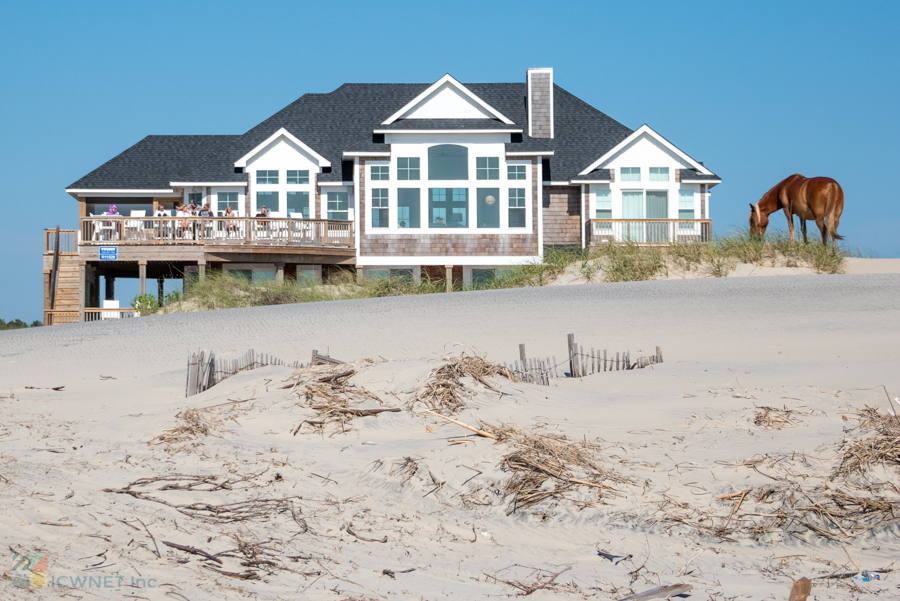
Frequently Asked Questions
What are the Corolla Wild Horses?
The Corolla Wild Horses are a group of feral Spanish mustangs that live in the 4WD beach area north of Corolla, and just south of the Virginia border. They are believed to be descendants of shipwrecked horses from hundreds of years ago.
Where are the Corolla Wild Horses?
The Corolla Wild Horses live on the miles-long stretch of shoreline that is in between the town of Corolla and the Virginia state line. This shoreline is only accessible by 4WD vehicles, and is very remote and isolated.
Are the Corolla Wild Horses on the beach?
The Corolla Wild Horses are often spotted along the beach, walking by the oceanfront. They can also sporadically be seen in the sand dunes, and in wooded neighborhoods in the Carova area.
How can you see the Corolla Wild Horses?
Visitors who head to the 4WD beaches north of Corolla may encounter the Corolla Wild Horses along the beach, in the dunes, or in quiet residential neighborhoods. There are also a number of tours that frequent areas where the wild horses roam, and which utilize 4WD Jeeps and other vehicles to find the horses.
Are there tours to see the Corolla Wild Horses?
A number of 4WD tours to see the Corolla Wild Horses are available, which include privately owned businesses based in Corolla, as well as seasonal tours that are offered by the Corolla Wild Horse Fund and Museum.
Where did the Corolla Wild Horses come from?
The Corolla Wild Horses are thought to be the descendants of shipwrecked or deposited Spanish mustangs from the 16th century. 1500s explorers such as Lucas Vasquez de Allyon in 1521 and Richard Greenville in the 1580s may have landed on the northern Currituck Banks and / or lost vessels or livestock in the northern Outer Banks area.
How long have the Corolla Wild Horses been on the Outer Banks?
The Corolla Wild Horses are believed to have landed on the Outer Banks in the 16th century, and may have arrived as early as 1521 via an expedition led by Lucas Vasquez de Allyon.
Where can you find wild horses on the Outer Banks?
The Corolla Wild Horses are located in the northernmost beaches of the Outer Banks, in the 4WD area that’s just north of Corolla. Wild horses, also known as Wild Ponies, are also found on Ocracoke Island, and can be viewed at the Ocracoke Pony Pen just south of the Hatteras / Ocracoke ferry docks.
Are the Corolla Wild Horses descendants of shipwrecks?
The Corolla Wild Horses are most likely the descendants of shipwrecks from 16th century explorers. Recent DNA testing has shown that the herd does share genetics with Spanish mustangs, which were common passengers on exploratory vessels in the 1500s.
Can you pet the Corolla Wild Horses?
It is illegal to approach, touch, or pet the Corolla Wild horses. *Visitors must remain at least 50 feet away from the wild horses.*
Can you feed the Corolla Wild Horses?
It is illegal to feed the Corolla Wild Horses, and doing so can be dangerous to their health. When these feral horses ingest apples, carrots, lettuce, or other non-local foods, they can develop colic and digestion problems.
What do the Corolla Wild Horses eat?
The Corolla Wild Horses have been eating a native diet of sea oats, coastal grasses, acorns, persimmons, and other area vegetation for hundreds of years.
Can you take photos of the Corolla Wild Horses?
Visitors are free to take photos of the Corolla Wild Horses, provided that they stay at least 50 feet away from the horses at all time.
What should you do is you see a Corolla Wild Horse?
Visitors should keep a safe distance from the Corolla Wild Horses if they encounter them on the beach. Though they look docile, these horses are inherently feral, and should not interact with humans.
Do Corolla Wild Horses show up at vacation homes?
Vacationers at Carova and 4WD beach area vacation homes regularly report seeing the Corolla Wild Horses in their backyards or neighborhoods, especially in quiet locations.
Are there vacation homes near the Corolla Wild Horses?
The Carova area has a wide array of vacation rental homes along the beaches and in the wooded soundside region, where the Corolla Wild Horses regularly make appearances.
Can you adopt a Corolla Wild Horse?
While visitors can’t physically adopt and / or take home one of the Corolla Wild Horses, they can sponsor a horse through the Corolla Wild Horse Fund and Museum, which is a local organization that supports the horses.
How many Corolla Wild Horses are there?
There are approximately 100 Corolla Wild Horses on the northern Outer Banks. This count is determined every fall by helicopter surveillance in the northern Corolla and Carova areas.
How do you help support the Corolla Wild Horses?
Horse fans can help support the Corolla Wild Horses via the Corolla Wild Horse Fund and Museum, which is a local organization that helps support and tend to the local herd. The Corolla Wild Horse Fund accepts donations, and offers special programs including wild horse tours, and “adopt a horse” initiatives.
Is there a museum about the Corolla Wild Horses?
Visitors can find out more about the Corolla Wild Horses with a visit to the Corolla Wild Horse Fund's Museum, which is located in the heart of Corolla.
How do you find out more about the Corolla Wild Horses?
Visitors can learn more about the Corolla Wild Horses via the Corolla Wild Horse Fund. This local organization has a museum in Corolla, as well as website with in-depth information about the Corolla Wild Horses. In addition, educational tours are available through the Corolla Wilde Horse Fund, as well as privately owned tour companies.
How are Corolla Wild Horses different from regular horses?
The Corolla Wild Horses, which are descendants of colonial Spanish mustangs, have a few distinguishing characteristics. Their tails are low and set on a sloping croup, their faces are narrow, and their ears are curled at the tip. They are also narrow throughout the chest, and have five lumbar vertebrae as opposed to six, which is much more common in modern American domestic breeds.
Who takes care of the Corolla Wild Horses?
The Corolla Wild Horses are not owned by any individual or organization, but they are supported by the Corolla Wild Horse Fund, whose mission is to protect, conserve, and responsibly manage the horses that roam freely on the northern Currituck Banks.
Why do the Corolla Wild Horses travel in groups?
The Corolla Wild Horses are territorial and stick to areas that they know, and that are close to where they were born. Within the herd, there are often male leaders that form their own individual “families” of horses, which in turn appear in groups along the shoreline.
How far do the Corolla Wild Horses roam?
The Corolla Wild Horses stick to the northern beaches of the Currituck Banks, where there are no paved roads and little development. Within this miles-long area, they may travel anywhere from 15-25 miles per day.
OuterBanks.com would like to thank Wild Horse Adventure Tours for supporting this content. Wild Horse Adventure Tours are seasoned vets when it comes to searching for the wild horses in their 4x4 off road tours. Their open-air cruises traverse beaches, dunes and Maritime forests with exclusive access to a wild horse sanctuary. Wild Horse Adventure Tours was ranked as the #1 tour in the USA by Tripadvisor and 2018 Business of the Year by the OBX Chamber of Commerce. Check out the wild horses in their tour video here, or call 252-489-2020 for more information.
